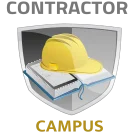Pile Drivers
Timber, precast concrete, steel H-piles and large tubular piles are driven into the ground by a pile driver striking the pile head. Small tubular piles and cast-in-place concrete pile shells are most often dragged into the ground by a core. The core is forced into the ground by a conical hammer and pulls the casing or tube with it.
The hammer of a mechanical impeller functions as a piston driven by steam, compressed air, or the internal combustion of diesel fuel.
A vibrating hammer is secured to the head of a pile and operates by delivering vibrations to the pile head in up and down cycles at varying speeds up to approximately 100 fps. These vibrations create compression waves in the pile, which in turn produce small amounts of expansion and contraction. As the pile expands longitudinally, it displaces the soil at the tip of the pile, and the weight of the pile, hammer, and equipment pushes the pile into the small void. At the same time as the pile expands in length, it contracts slightly in diameter and relieves friction between the soil and the surface of the pile. This relief from friction helps the pile move downward.
These movements are very small but occur 100 times per second; As a result, penetration can be quite rapid. For example, a pile that may require an hour of setting with a steam hammer can be driven in 2 or 3 minutes with a vibratory hammer. This type of equipment works best in sandy soils, but can be used in silt, clay, or soils containing layers of gravel.
Assistance may need to be provided when driving piles. This is particularly true when driving precast piles in granular soils. The high rate of friction makes driving very difficult. The assistance generally takes the form of a jet of water that dilates the soil at the tip of the pile. The water is expelled through the hollow center and returns to the surface around the outside of the pile.

